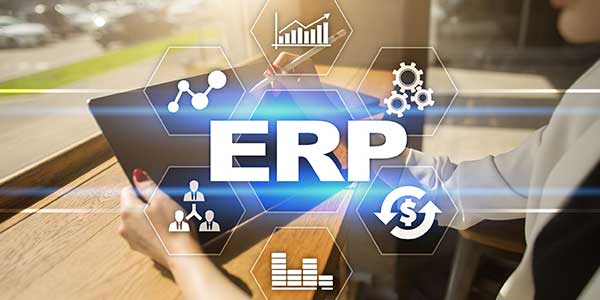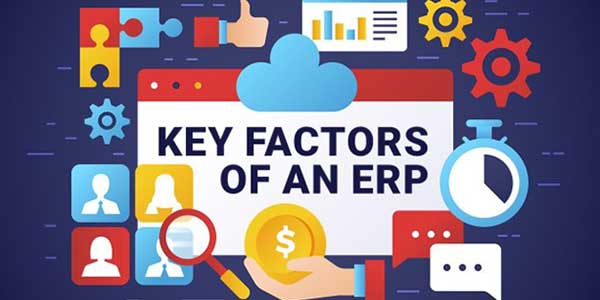
In today’s quickly advancing business scene, staying competitive requires more than offering quality items or services. It demands efficient and streamlined operations, seamless communication, and effective management of resources. As a result, Enterprise Resource Planning (ERP) frameworks have become an integral factor. ERP has revolutionized how organizations handle their day-to-day activities, integrating various departments and functions into a centralized platform. Here, we will dig into the world of ERP, exploring its benefits, key features, implementation challenges, and role in driving business growth. TMR Consult offers a complete range of consultancy services on various Microsoft business applications, including enterprise resource planning (ERP) and customer relationship management (CRM), to transform your business into an ultra-efficient and customer-centric organization.
Table of Contents
1.) Understanding Enterprise Resource Planning ERP:
1.1) What Is ERP?
Enterprise Resource Planning (ERP) is a solution of software that incorporates various business functions and processes into a unified system. It enables organizations to streamline operations, enhance efficiency, furthermore settle on informed choices because of continuous information. In addition, ERP serves as a centralized database that connects different departments, such as finance, human resources, manufacturing, supply chain, and customer service, providing a holistic view of the organization’s activities.
1.2) The Evolution Of ERP Systems:
ERP originated in the 1960s when businesses began using software to automate specific organizational tasks. Over time, these systems evolved to encompass a broader range of functionalities and integrate multiple departments. In the 1990s, ERP systems experienced significant growth and became more accessible to businesses of all sizes. In addition, with technological advancements, ERP systems have become more sophisticated, offering features such as cloud-based deployment, mobile accessibility, and advanced analytics.
1.3) Key Components Of An ERP System:
An ERP system comprises several key components that facilitate smooth operations. These components include:
- Centralized Database: ERP systems store all relevant data in a centralized database, ensuring consistency and integrity across different modules and departments.
- Modules: ERP modules represent different functional areas of an organization, such as finance, inventory management, procurement, human resources, and customer relationship management. Each module focuses on specific processes and contains relevant data and features.
- Integration: ERP systems enable seamless integration among various modules, ensuring the flow of information and real-time updates. Integration eliminates data duplication and further develops data precision.
- Automation: ERP automates routine tasks, such as data entry, report generation, and workflow approvals. Automation reduces manual exertion and limits the gamble of blunders.
1.4) How ERP Works?
ERP systems capture data from different departments and processes and store it in a centralized database. The data enters manually or generated automatically from integrated systems. ERP systems provide a user-friendly interface that allows employees to access relevant information, perform tasks, and generate reports based on their roles and responsibilities. ERP also facilitates cross-departmental collaboration by enabling employees to share information and work together on common goals. Moreover, ERP systems offer reporting and analytics capabilities, providing organizations with insights into their operations. They can generate customized reports, analyze trends, and make data-driven decisions to drive business growth.
2.) Benefits Of Implementing An ERP System:
2.1) Streamlined Processes And Improved Efficiency:
One of the primary benefits of implementing an ERP system is streamlining business processes and improving overall efficiency. ERP integrates various departments and functions, eliminating redundant and manual tasks. By automating routine procedures, such as data entry, report generation, and workflow approvals, ERP reduces the time and effort expected to perform these errands, permitting workers to zero in on more worthy added exercises. This streamlining of processes leads to improved productivity, reduced errors, and faster turnaround times.
2.2) Enhanced Data Visibility And Decision-Making:
ERP provides real-time access to accurate and up-to-date information across the organization. This enhanced data visibility gives decision-makers a comprehensive view of operations, performance, and financials. With accurate data, managers can make informed decisions quickly and confidently. They can track key performance indicators, identify trends, and examine information to distinguish regions for development and capitalize on opportunities. The availability of integrated data also promotes data-driven decision-making and facilitates strategic planning.
2.3) Cost Reduction And Resource Optimization:
ERP systems contribute to cost reduction and resource optimization in multiple ways. By streamlining processes and eliminating manual tasks, ERP decreases the extra staff or assets requirement. Automation reduces human errors, minimizing the risk of costly mistakes. Moreover, ERP enables organizations to optimize inventory levels, manage procurement more effectively, and reduce carrying costs.
2.4) Improved Collaboration And Communication:
Effective collaboration and communication are essential for organizational success. ERP systems facilitate improved collaboration by breaking down information silos and enabling cross-departmental communication. As a result, employees can collaborate seamlessly on projects and tasks with integrated data and shared workflows.
2.5) Scalability And Flexibility:
As organizations grow and evolve, scalability and flexibility become fundamental factors. The developers design ERP systems to accommodate business growth and changes. They provide scalability by allowing organizations to add new modules or functionalities as needed, supporting expansions into new markets, or adding new business units. Additionally, ERP systems offer flexibility by providing customizable features and workflows tailored to specific business requirements.
3.) Key Factors Of An ERP System:
3.1) Financial Management:
Financial management is a crucial component of an ERP system. It includes general ledger, accounts payable and receivable, cash management, budgeting, and financial reporting. As a result, ERP systems provide real-time visibility into financial data, enabling organizations to track revenue, expenses, and profitability. Financial management modules also facilitate accurate and efficient financial transactions, streamline financial processes, and ensure compliance with accounting standards.
3.2) Supply Chain Management:
Supply chain management (SCM) within an ERP system helps organizations manage the flow of goods, materials, and information from procurement to delivery. SCM features include inventory, demand forecasting, procurement, order management, and logistics. ERP systems enable organizations to optimize inventory levels, monitor supplier performance, streamline procurement processes, and improve supply chain visibility.
3.3) Human Resource Management:
Human Resource Management (HRM) modules within ERP systems automate and centralize HR processes, including employee data management, payroll, benefits administration, performance management, and recruitment. As a result, HRM features streamline administrative tasks, improve accuracy in payroll processing, and enable effective talent management.
3.4) Customer Relationship Management:
Customer Relationship Management (CRM) modules within ERP systems focus on managing customer interactions and improving customer satisfaction. CRM features include sales force automation, marketing campaign management, customer service, and contact management. CRM within ERP enhances customer engagement, improves sales effectiveness, and helps organizations to build stronger customer relationships.
3.5) Manufacturing And Production Planning:
Manufacturing and production planning modules within ERP systems support the efficient management of production processes. These features include production scheduling, material requirements planning (MRP), shop floor control, quality management, and product lifecycle management.
3.6 Reporting And Analytics:
Reporting and analytics capabilities are essential components of an ERP system. ERP systems provide tools for generating customized reports, dashboards, and data visualizations. These features allow organizations to analyze data, track key performance indicators (KPI), and gain insights into various aspects of their operations.

4.) Implementing An ERP System:
4.1) Evaluating Organizational Needs And Selecting The Right ERP Solution:
Before implementing an ERP system, it is crucial to evaluate the specific needs and requirements of the organization. It involves identifying pain points, analyzing existing processes, and determining the desired outcomes. In addition, organizations should involve key stakeholders from different departments to gather insights and define objectives. Based on this evaluation, the organization can select the most suitable ERP solution that aligns with its needs, industry requirements, and scalability.
4.2) Planning The Implementation Process:
Proper planning is essential for a successful ERP implementation. It involves creating a detailed project plan, setting timelines and milestones, and allocating necessary resources. The implementation team should include representatives from different departments to ensure comprehensive coverage of business processes. Clear communication and coordination among team members are crucial during this phase to ensure a smooth implementation process.
4.3) Data Migration And System Integration:
Data migration involves transferring existing data from legacy systems or spreadsheets to the new ERP system. This process requires careful planning to ensure data accuracy and consistency. The implementation team should map data fields, clean and validate data, and establish data conversion rules. System integration involves connecting the ERP system with existing systems, such as CRM or third-party applications, to ensure seamless data flow and functionality.
4.4) Training And Change Management:
Proper training is vital to ensure that employees can effectively use the new ERP system. Training programs should be designed based on user roles and responsibilities, covering the functionalities relevant to each department. The implementation team should provide comprehensive training materials, conduct workshops or webinars, and offer hands-on practice sessions. Change management is also crucial to address any resistance to the new system. Communication, engagement, and support are essential to managing the organizational change associated with ERP implementation.
4.5) Testing And Go-Live:
Before going live, thorough ERP system testing is necessary to ensure its functionality, stability, and compatibility. It includes testing scenarios, workflows, and integrations to identify and resolve issues or bugs. Once the testing phase is complete, the organization can proceed with the go-live phase, where the ERP system is officially launched and made accessible to all users.
4.6) Post-Implementation Support And Maintenance:
Support and maintenance become crucial after implementing the ERP system and live post-implementation. The organization should establish a support structure to address any user questions, issues, or technical problems that may arise. Regular system maintenance should include updating, patches, and security measures to ensure optimal performance and data integrity.
5.) Challenges And Considerations:
5.1) Cost Considerations And Return On Investment (ROI) :
Executing an ERP system can be a critical speculation for associations. The cost includes software licenses, hardware infrastructure, implementation services, training, and ongoing maintenance. Therefore, organizations must carefully evaluate the total cost of ownership and calculate the potential return on investment (ROI) to justify the expense. ROI calculations should consider tangible benefits, such as cost savings and increased Productivity, and intangible benefits, such as improved decision-making and customer satisfaction.
5.2) Resistance To Change And Organizational Culture:
Implementing an ERP system requires changes in processes, workflows, and job responsibilities. It can lead to resistance from employees accustomed to existing systems and processes. Addressing resistance to change is crucial for successful implementation. Organizations should invest in change management strategies, including communication, training, and engaging employees. Aligning the performance with the organizational culture and emphasizing the benefits of the ERP system can help overcome resistance and foster a positive transition.
5.3) Data Security And Privacy Concerns:
ERP systems centralize and store vast amounts of sensitive business data. Ensuring data security and protection is of the most extreme significance. Organizations must assess and address potential risks, execute reasonable safety efforts, and comply with significant guidelines such as GDPR or industry-specific compliance requirements. It includes implementing access controls, encryption, data backup, and disaster recovery plans. Regular audits and monitoring can help identify and address security vulnerabilities.
5.4) Customization And Integration Challenges:
Every organization has unique requirements and processes. Customization of the ERP system may be necessary to align with specific needs. However, excessive customization can increase implementation complexity, cost, and maintenance efforts. Balancing customization with standard ERP functionality is crucial. Additionally, integrating the ERP system with existing systems, such as CRM or legacy applications, can pose challenges. Organizations should carefully plan and prioritize integration efforts to ensure smooth data flow and interoperability.
5.5) Vendor Selection And Collaboration:
Choosing the right ERP vendor is critical for a successful implementation. Organizations should consider vendor reputation, industry experience, product roadmap, support services, and long-term viability. Collaborating closely with the vendor throughout the implementation process. Establishing clear communication channels, defining project milestones, and ensuring vendor commitment is vital to success. Strong collaboration helps address issues promptly, align expectations, and support the vendor during and after implementation.
6.) Future Trends And Emerging Technologies In ERP:
6.1) Cloud-Based Erp Solutions:
Cloud-based ERP solutions are gaining popularity due to their flexibility, scalability, and cost-effectiveness. Associations can access their ERP framework through the cloud, removing the requirement for an on-premises foundation and decreasing support costs. Cloud-based ERP solutions also offer easier collaboration, as multiple users can access and update data in real-time from anywhere, facilitating remote work and distributed teams. As cloud technology advances, we can expect more organizations to adopt cloud-based ERP solutions.
6.2) Mobile ERP And Remote Access:
Mobile ERP applications are becoming essential for on-the-go access to critical business information with the increasing use of mobile devices. Mobile ERP solutions allow employees to access real-time data, perform tasks, and make informed decisions from their smartphones or tablets. In addition, remote access to ERP systems enables employees to stay connected and productive even when away from their desks. As mobile technology evolves, mobile ERP applications will become more powerful and user-friendly.
6.3) Artificial Intelligence And Machine Learning Integration:
Artificial intelligence (AI) and machine learning (ML) transform ERP systems by enabling intelligent automation, predictive analytics, and advanced data insights. AI-powered ERP systems can automate repetitive tasks, optimize workflows, and provide intelligent recommendations for decision-making. ML algorithms can break down immense measures of information to distinguish designs, detect anomalies, and make accurate predictions. Integrating AI and ML capabilities into ERP systems enhances efficiency, improves accuracy, and drives proactive decision-making.
6.4) Internet Of Things (IoT) And Industry 4.0:
The Internet of Things (IoT) revolutionizes manufacturing and supply chain industries. IoT devices like sensors and intelligent machines can collect real-time data from various sources, providing valuable insights into operational performance and product quality. Integrating IoT data with ERP systems enables organizations to monitor and control production processes, optimize inventory management, and enhance supply chain visibility. As Industry 4.0 advances, the integration of IoT and ERP will become increasingly critical for intelligent manufacturing and efficient operations.
6.5) Blockchain And ERP:
Blockchain technology offers secure and transparent transactions, making it valuable for ERP systems. In addition, blockchain can provide enhanced data security, traceability, and immutability, which is particularly important for industries with complex supply chains. As blockchain adoption expands, we expect increased integration with ERP systems to enhance data integrity and trust.
These arising innovations can alter the ERP landscape, enabling organizations to leverage advanced capabilities for improved efficiency, decision-making, and competitiveness.
Conclusion:
Enterprise Resource Planning (ERP) systems have transformed business operations, streamlining processes, improving efficiency, and enabling better decision-making by integrating various departments and functions into a centralized platform. ERP brings numerous benefits, including enhanced collaboration, cost reduction, and improved resource management. In addition, cloud-based solutions, mobile access, and AI integration will further revolutionize ERP. As businesses strive to stay competitive in a rapidly changing environment, embracing ERP is becoming increasingly vital for sustainable success.

 About the Author:
About the Author:
















“Thank you so much for liking my blog post! I truly appreciate your support and it means a lot to me that you enjoyed the content. Your positive feedback encourages me to continue sharing valuable information and insights.
Welcome here and thanks for reading our article and sharing your view. This will be very helpful to us to let us motivate to provide you with more awesome and valuable content from a different mind. Thanks again.
In today’s quickly advancing business scene, staying competitive requires more than offering quality items or services
Welcome here and thanks for reading our article and sharing your view. This will be very helpful to us to let us motivate to provide you with more awesome and valuable content from a different mind. Thanks again.